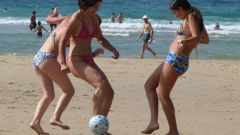Instruction
1
Racket for badminton are available in three versions: home, basic and professional. Good rackets are always sold as one piece in an individual case that protects the grid. Be sure to include a passport or certificate, which identifies the main characteristics. This racket may not be cheaper 700-800 rubles.
2
Pay attention to the material from which made the racket. Rackets for beginners are made of steel or aluminum. They are more heavy, but higher strength. The rim of this racket is designed for less strong stretch.
3
Look at the racket. The models intended for Amateurs and beginners, the rim is attached to the rod using the T-shaped joint. Racket for professionals are made of a titanium-graphite or graphite alloys fully. They are very light, the body is a whole. But the Pro racquets have less strength and therefore can easily be damaged by careless blow on the floor or rack of the grid.
4
The generally accepted length of a racket for game in badminton – 665 mm. For professional players there are longer versions with 675 mm length or extra length – 680 mm.
5
The main parameters are mass, stiffness of the rod and balance. Racket weighs 81-150 grams, excluding the strings and the windings. Professional model-class is very lightweight, have a weight of 81 to 84 gr. The weight of the racket can be specified on the web or in the certificate letter designations: 2U/W2 (90-94гр) - Amateur and basic models, 3U/W3 (85-89гр), 4U/W4 (80-84гр) – rackets for professional players, 5U/W5 (75-79гр) - extra light model-only players of the highest class.
6
The stiffness of the rod of the racket affects the machining accuracy of the shuttlecock. As a rule, the higher the class of a badminton player, the stiffer the racket he chooses for the game. Playing with a stiff racket untrained athlete can be very hard, moreover it is very easy to injure your wrist. Stiffness is denoted by English terms: Medium – flexible, Stiff – partially flexible, Extra Stiff – minimum flexibility. Sometimes used digital signage rigidity of the rod: 8,0-8,5 – hard or 9.0 to 9.5 flexible.
7
The following important factor - balance. The stronger the balance offset in the rim, the stronger the attack; such rackets is usually played professional badminton players of high class. Also these rackets I prefer to use players of the attacking plan. But together with a shift of balance in the rim is reduced accuracy, so for those who are just learning to play badminton, it is better to choose rackets with a neutral balance or a small offset in the handle.
8
If the passport is not specified, the balance of the racket or you take an inventory with the owner, try to determine the balance yourself. To do this, put the racquet on the edge of your index finger and locate the point where the handle and rim are trimmed. Then measure the distance from the end of the handle to the found point. If the balance is shifted towards the rim, the distance must be equal to 295-305 mm, with a neutral balance - of 290-300 mm, the displacement of the balance in the handle 285-295 mm.
9
There are additional parameters that are different badminton rackets. It is the thickness of the winding, the tensile force of the mesh, the thickness of the strings, the shape of the rim and so on. But for the novice player, these settings don't matter much.
10
Choosing a racket in the store, be sure to make it a few moves that mimic the hitting the shuttlecock. Even with the same basic parameters of the rackets of different companies may vary. Focus on your feelings. Choose the racket that is most conveniently lies in your hand.
Useful advice
If your city has a badminton section, please contact for advice on choosing a racket to coach. Very often in the sports section you will be able to suggest a good badminton racket at a lower price than the store, and to give professional advice tailored to your individual parameters.
90% of all badminton players in the world playing racket firms Yonex.
90% of all badminton players in the world playing racket firms Yonex.





